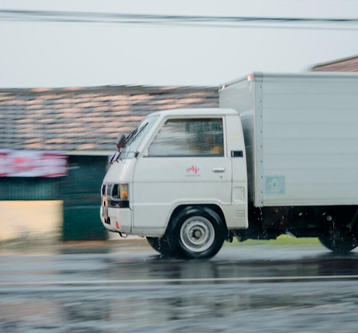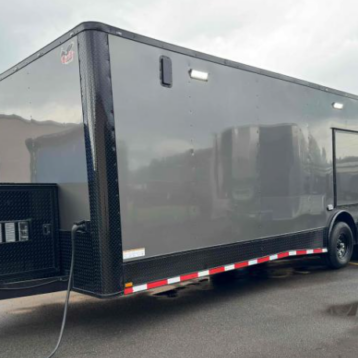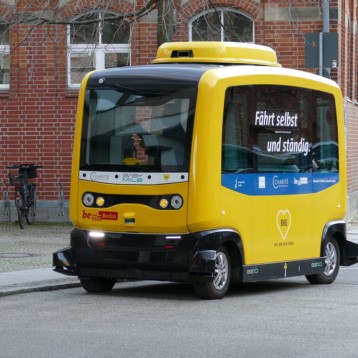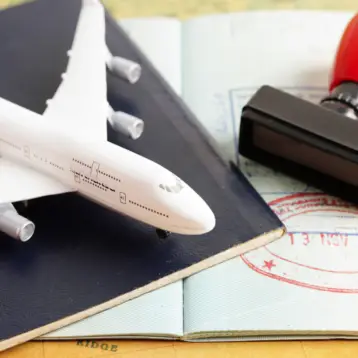|
The Paralight is an unmanned motorized parachute controlled by a joystick connected to an exceptionally powerful servo, which tilts the weight of the craft to the right or left, thus controlling the direction of the flight. The altitude is determined by the number of the engine’s revolutions per minute (RPM), which lifts the machine when increased and lowers it when decreased. The scientists say the benefits of such a design are in its operating simplicity, steadfastness and floating capabilities – the prototype of the craft, which was already tested, proved to be able to hover slowly and in a stable manner. Paralight can be launched from any terrain and the craft’s control range extends to distances reaching 1.5 km.
Paralight was designed specifically for purposes of aerial photography. The craft can carry standard photographic equipment, which is connected to a transmitter for relaying the pictures to recording devices such as video cameras, VCRs, or DVDs on the ground. Standard video or digital still cameras can also be mounted on the craft, with the desired photography mode selected prior to takeoff.
Paralight’s inventors say the aircraft can be used as a reliable and speedy means to observation in service of various rescue forces, as well as a supervising tool for officials of national parks, nature reserves, and safaris. Paralight can also be useful for those wishing to capture quality aerial photographs or video in a cost-efficient way; the received pictures can be used to map and track animal movements on the ground as well as provide terrain information for trekkers, farmers or security professionals. Paralight developers say that the system can also be used to serve as an aerial communication antenna, as well as a high-standard photography kit for nature enthusiasts.
|
“Along with the progression of wireless technologies, we witness an increasing demand for aerial photography solutions. We see this both in firms providing security services, as well as those in charge of the managing catastrophes and natural disasters, which sadly have befallen and continue to threaten populations all over the world” – said Moshe Roimi, CEO of Paralight Aviation. The company has already approached a number of potential clients, with whom they’ve performed several tests of the aircraft’s prototype. In one such experiment, which was conducted in collaboration with an Israeli fire fighter force squad, the craft was tested in a 40-minute flight over the northern part of the country, delivering real-time photos to the teams on the ground.
Roimi told TFOT that Paralight’s technology has a distinctive advantage compared to existing technologies such as Unmanned Aerial Vehicles (UAVs), both in terms of purchase and in terms of maintenance and operational costs. Unlike UAVs which usually require a trained personal to operate and maintain, the Paralight can be operated in the field by a single person with very minimal training. The low cost of the system can also make it perfect for use as a backup to more expensive aerial photography systems.
Paralight Aviation looks forward to making additional upgrades to their system – one of the goals the company is pursuing is to improve the aircraft’s abilities to operate in extreme weather conditions. The company also strives to further decrease the device in both size and weight, and to make it easily configurable in a way which will allow it to be ready-to-work within minutes. The inventors say that Paralight’s future model is planned to be controlled by such means as a cellular phones, GPS, or dedicated software, which would have been fed the mission layout and requirements in advance.
Paralight engineers are currently working on the next generation prototype of the airborne craft, which they say will most likely be ready in 12 months time. The estimated price for such a system falls somewhere in the range of $5,000 – $10,000, far lower than most existing UAV solutions.
TFOT has covered a number of impressive aerial crafts including a bat-inspired spy plane and the “L15” airship that is fully optimized for surveillance missions. TFOT also recently covered another innovative Israeli unmanned aerial vehicle named TCUAV, developed by the Israeli Company Planum Vision. The TCUAV is powered by electricity from cables installed on dedicated electric towers transmitted to the device through a wire, laid out as an aerial railway on which the vehicle moves.
More information on the Paralight can be found on Paralight Aviation’s website.
TFOT and Paralight Aviation are offering a 5% discount coupon for any of the aviation systems on Paralight’s website. Simply enter the TFOT code (T070815) when you are asked to on the Paralight website online order form (in the “Coupon Number” line).












